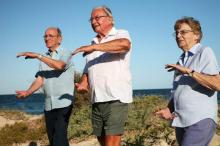ROME – Tai chi is as effective as standard physical therapy in reducing pain and improving physical function and quality of life in patients with knee osteoarthritis, according to the results of a randomized, single-blind study reported at the European Congress of Rheumatology.
The primary outcome of change in the Western Ontario and McMaster Universities Osteoarthritis Index (WOMAC) pain subscale score from baseline to 12 weeks was –167.2 mm in the patients randomized to the tai chi group vs. –143.0 mm in those who completed a standard physiotherapy program (P = .16).
“Future studies of ‘Eastern’ complementary medicine will further inform ‘Western’ medical treatment guidelines,” said Dr. Chenchen Wang, director of the Center for Complementary and Integrative Medicine at Tufts Medical Center in Boston. She noted that the study findings showed that tai chi could be a viable alternative to physical therapy for knee osteoarthritis (OA), which she called “a chronic disabling disease.”
Dr. Wang andher associates have previously shown that the classic Yang-style tai chi results in clinically important improvements in patients with fibromyalgia (N. Engl. J. Med. 2010;363:743-54). They have also previously reported beneficial effects in small numbers of patients with knee OA (Arthritis Rheum. 2009;61:1545–53). The present study findings replicate these results in a larger group of patients followed up for a longer period of time.
“This is the longest follow-up of tai chi for knee osteoarthritis to date,” Dr. Wang observed. It is also representative of a racially diverse population, she said. The study is ongoing but not recruiting participants and will continue to compare the effectiveness and cost-effectiveness of the Chinese martial art vs. standard-of-care physiotherapy for 1 year (BMC Complement. Altern. Med. 2014;14:333).Of 204 randomized patients with a mean age of 60 years and disease duration of 8 years, 167 (82%) completed the tai chi sessions and 12-week evaluation for the primary end point. In addition, three-quarters of patients completed 24 weeks and 69% completed 1 year of the intervention, showing the sustainability of the exercise program. Overall attendance was similar between the groups, at 74% for tai chi and 81% for physical therapy.
The 106 patients randomized to the tai chi group performed the martial art twice a week for 12 weeks while the 98 patients in the physical therapy group underwent twice-weekly sessions for the first 6 weeks, then continued with ”rigorously monitored” exercises at home for 12 additional weeks. Patients knew to which group they had been randomly assigned, but the study physician and outcomes assessments were blinded to the treatment allocation.
Similar benefits were seen for with both strategies for the secondary end points of physical function subscale of the WOMAC (P = .08), Patients’ Global Assessment (P = .06), and chronic pain self-efficacy (P = .22). There were also similar improvements in 6-minute (P = .76) and 20-meter (P = .40) walking tests.
Health-related quality of life measured using the Short Form 36 suggested a possible statistical advantage of tai chi over physical therapy for the physical but not mental component summary, with mean differences between the groups of 3.2 (P < .01) and 1.6 (P = .08), respectively. There was also a statistical difference in depression scores between the groups, but this may not be clinically significant, Dr. Wang observed.
“This study provides evidence to support both tai chi and physical therapy improve pain and physical function for patients with knee osteoarthritis,” she said. “Interestingly, we didn’t see any differences in effectiveness attributable to the four individual tai chi instructors.”
The National Center for Complementary and Integrative Health of the National Institutes of Health supported the study. Dr. Wang reported no relevant conflicts.

